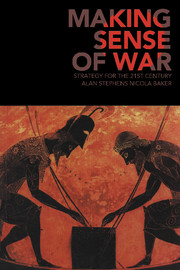Book contents
- Frontmatter
- Contents
- Abbreviations
- Preface
- Introduction
- Chapter 1 How to win
- Chapter 2 Stove-piped strategy
- Chapter 3 Traditional warfighting concepts and practices
- Chapter 4 Manoeuvre and the application of force
- Chapter 5 Shaping the strategic environment
- Chapter 6 Strategic paralysis
- Chapter 7 Contemplating war
- Chapter 8 Constraints on war
- Chapter 9 Controlling war
- Chapter 10 Peacemaking
- Chapter 11 War in the twenty-first century
- Notes
- Select bibliography
- Index
Chapter 6 - Strategic paralysis
Strategy as an ideal
Published online by Cambridge University Press: 05 June 2012
- Frontmatter
- Contents
- Abbreviations
- Preface
- Introduction
- Chapter 1 How to win
- Chapter 2 Stove-piped strategy
- Chapter 3 Traditional warfighting concepts and practices
- Chapter 4 Manoeuvre and the application of force
- Chapter 5 Shaping the strategic environment
- Chapter 6 Strategic paralysis
- Chapter 7 Contemplating war
- Chapter 8 Constraints on war
- Chapter 9 Controlling war
- Chapter 10 Peacemaking
- Chapter 11 War in the twenty-first century
- Notes
- Select bibliography
- Index
Summary
IN AN IDEAL WORLD, every strategic action would achieve its desired outcome as quickly and efficiently as possible. Precisely how we might measure those descriptors is likely to vary from case to case, but the criteria would usually include minimum costs in terms of casualties and treasure, minimum damage to the environment and to any infrastructure, and an end-state acceptable to most parties, including the vanquished. It has been the allure of that kind of rapid, decisive outcome that has motivated such long-standing concepts as the decisive or great battle and the knockout blow, and which more recently has seen attention turn to strategic raids.
A central feature of each of those concepts is the priority placed on speed. All things being equal, a rapid conclusion offers the best chance of achieving the best outcome, for the obvious reason that the shorter the fight, the less time there is for both sides to kill people and break things. Speed can also make a major contribution to surprise, a tactical advantage which in itself can shorten conflicts.
Speed is a relative term and it has a number of dimensions. The Mongol armies that rampaged through Asia and Europe in the thirteenth and fourteenth centuries ce travelled light and drove their horses relentlessly, sometimes covering 200 kilometres in two days, a previously unheard of rate of advance for armies.
- Type
- Chapter
- Information
- Making Sense of WarStrategy for the 21st Century, pp. 134 - 165Publisher: Cambridge University PressPrint publication year: 2006

